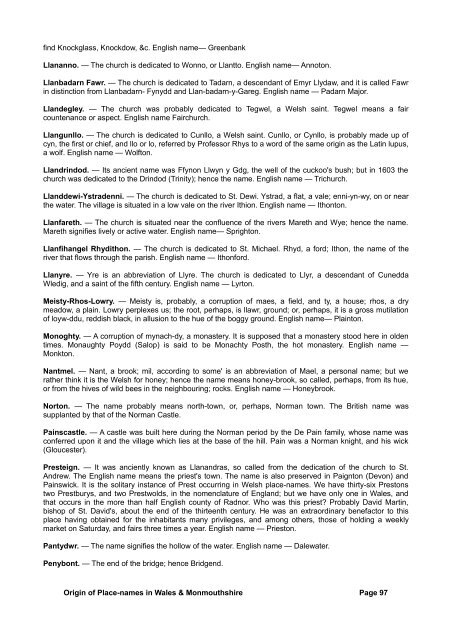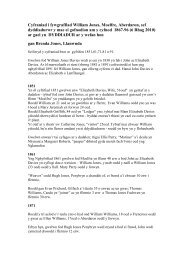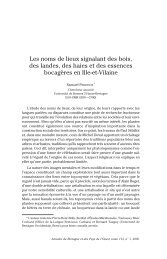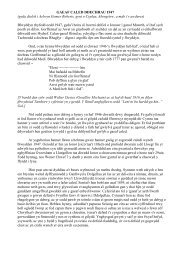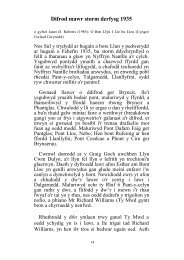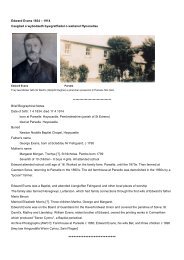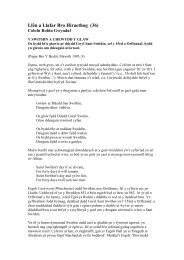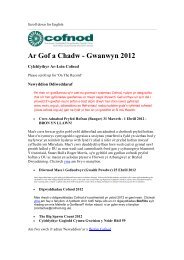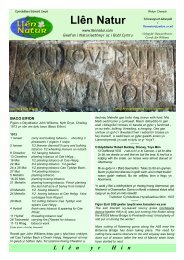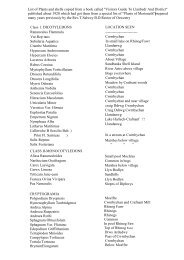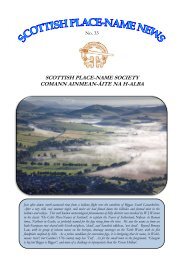handbook of the origin of place-names in wales and monmouthshire
handbook of the origin of place-names in wales and monmouthshire
handbook of the origin of place-names in wales and monmouthshire
- No tags were found...
Create successful ePaper yourself
Turn your PDF publications into a flip-book with our unique Google optimized e-Paper software.
f<strong>in</strong>d Knockglass, Knockdow, &c. English name— GreenbankLlananno. — The church is dedicated to Wonno, or Llantto. English name— Annoton.Llanbadarn Fawr. — The church is dedicated to Tadarn, a descendant <strong>of</strong> Emyr Llydaw, <strong>and</strong> it is called Fawr<strong>in</strong> dist<strong>in</strong>ction from Llanbadarn- Fynydd <strong>and</strong> Llan-badarn-y-Gareg. English name — Padarn Major.Ll<strong>and</strong>egley. — The church was probably dedicated to Tegwel, a Welsh sa<strong>in</strong>t. Tegwel means a faircountenance or aspect. English name Fairchurch.Llangunllo. — The church is dedicated to Cunllo, a Welsh sa<strong>in</strong>t. Cunllo, or Cynllo, is probably made up <strong>of</strong>cyn, <strong>the</strong> first or chief, <strong>and</strong> llo or lo, referred by Pr<strong>of</strong>essor Rhys to a word <strong>of</strong> <strong>the</strong> same <strong>orig<strong>in</strong></strong> as <strong>the</strong> Lat<strong>in</strong> lupus,a wolf. English name — Wolfton.Ll<strong>and</strong>r<strong>in</strong>dod. — Its ancient name was Ffynon Llwyn y Gdg, <strong>the</strong> well <strong>of</strong> <strong>the</strong> cuckoo's bush; but <strong>in</strong> 1603 <strong>the</strong>church was dedicated to <strong>the</strong> Dr<strong>in</strong>dod (Tr<strong>in</strong>ity); hence <strong>the</strong> name. English name — Trichurch.Ll<strong>and</strong>dewi-Ystradenni. — The church is dedicated to St. Dewi. Ystrad, a flat, a vale; enni-yn-wy, on or near<strong>the</strong> water. The village is situated <strong>in</strong> a low vale on <strong>the</strong> river Ithion. English name — Ithonton.Llanfareth. — The church is situated near <strong>the</strong> confluence <strong>of</strong> <strong>the</strong> rivers Mareth <strong>and</strong> Wye; hence <strong>the</strong> name.Mareth signifies lively or active water. English name— Sprighton.Llanfihangel Rhydithon. — The church is dedicated to St. Michael. Rhyd, a ford; Ithon, <strong>the</strong> name <strong>of</strong> <strong>the</strong>river that flows through <strong>the</strong> parish. English name — Ithonford.Llanyre. — Yre is an abbreviation <strong>of</strong> Llyre. The church is dedicated to Llyr, a descendant <strong>of</strong> CuneddaWledig, <strong>and</strong> a sa<strong>in</strong>t <strong>of</strong> <strong>the</strong> fifth century. English name — Lyrton.Meisty-Rhos-Lowry. — Meisty is, probably, a corruption <strong>of</strong> maes, a field, <strong>and</strong> ty, a house; rhos, a drymeadow, a pla<strong>in</strong>. Lowry perplexes us; <strong>the</strong> root, perhaps, is llawr, ground; or, perhaps, it is a gross mutilation<strong>of</strong> loyw-ddu, reddish black, <strong>in</strong> allusion to <strong>the</strong> hue <strong>of</strong> <strong>the</strong> boggy ground. English name— Pla<strong>in</strong>ton.Monoghty. — A corruption <strong>of</strong> mynach-dy, a monastery. It is supposed that a monastery stood here <strong>in</strong> oldentimes. Monaughty Poydd (Salop) is said to be Monachty Posth, <strong>the</strong> hot monastery. English name —Monkton.Nantmel. — Nant, a brook; mil, accord<strong>in</strong>g to some' is an abbreviation <strong>of</strong> Mael, a personal name; but wera<strong>the</strong>r th<strong>in</strong>k it is <strong>the</strong> Welsh for honey; hence <strong>the</strong> name means honey-brook, so called, perhaps, from its hue,or from <strong>the</strong> hives <strong>of</strong> wild bees <strong>in</strong> <strong>the</strong> neighbour<strong>in</strong>g; rocks. English name — Honeybrook.Norton. — The name probably means north-town, or, perhaps, Norman town. The British name wassupplanted by that <strong>of</strong> <strong>the</strong> Norman Castle.Pa<strong>in</strong>scastle. — A castle was built here dur<strong>in</strong>g <strong>the</strong> Norman period by <strong>the</strong> De Pa<strong>in</strong> family, whose name wasconferred upon it <strong>and</strong> <strong>the</strong> village which lies at <strong>the</strong> base <strong>of</strong> <strong>the</strong> hill. Pa<strong>in</strong> was a Norman knight, <strong>and</strong> his wick(Gloucester).Presteign. — It was anciently known as Llan<strong>and</strong>ras, so called from <strong>the</strong> dedication <strong>of</strong> <strong>the</strong> church to St.Andrew. The English name means <strong>the</strong> priest's town. The name is also preserved <strong>in</strong> Paignton (Devon) <strong>and</strong>Pa<strong>in</strong>swick. It is <strong>the</strong> solitary <strong>in</strong>stance <strong>of</strong> Prest occurr<strong>in</strong>g <strong>in</strong> Welsh <strong>place</strong>-<strong>names</strong>. We have thirty-six Prestonstwo Prestburys, <strong>and</strong> two Prestwolds, <strong>in</strong> <strong>the</strong> nomenclature <strong>of</strong> Engl<strong>and</strong>; but we have only one <strong>in</strong> Wales, <strong>and</strong>that occurs <strong>in</strong> <strong>the</strong> more than half English county <strong>of</strong> Radnor. Who was this priest? Probably David Mart<strong>in</strong>,bishop <strong>of</strong> St. David's, about <strong>the</strong> end <strong>of</strong> <strong>the</strong> thirteenth century. He was an extraord<strong>in</strong>ary benefactor to this<strong>place</strong> hav<strong>in</strong>g obta<strong>in</strong>ed for <strong>the</strong> <strong>in</strong>habitants many privileges, <strong>and</strong> among o<strong>the</strong>rs, those <strong>of</strong> hold<strong>in</strong>g a weeklymarket on Saturday, <strong>and</strong> fairs three times a year. English name — Prieston.Pantydwr. — The name signifies <strong>the</strong> hollow <strong>of</strong> <strong>the</strong> water. English name — Dalewater.Penybont. — The end <strong>of</strong> <strong>the</strong> bridge; hence Bridgend.Orig<strong>in</strong> <strong>of</strong> Place-<strong>names</strong> <strong>in</strong> Wales & Monmouthshire Page 97


